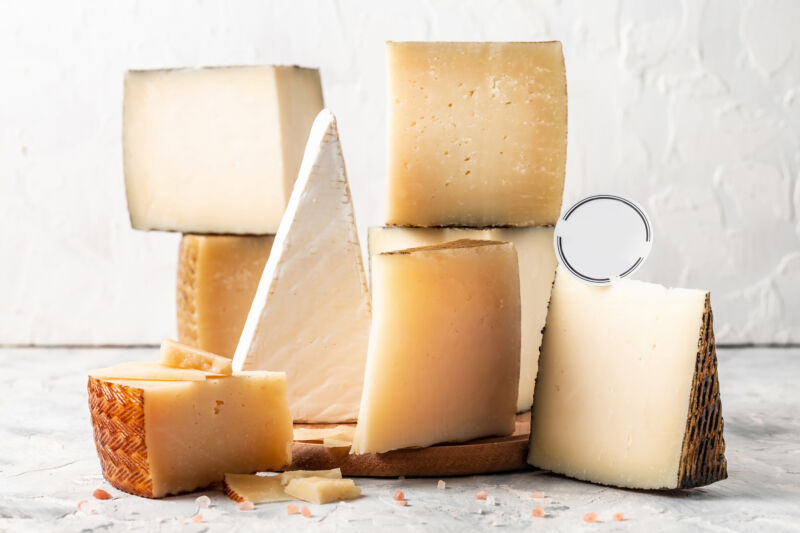There is no questioning our ongoing love affair with cheese. From pizza and pasta to that decadent slice of cheesecake, we can’t get enough. But the dairy industry that produces cheese has had a negative impact on our climate that is not exactly appetizing.
While plant-based alternatives to cheese are easier on the environment—not to mention ideal for those who are lactose intolerant (raises hand) or vegan—many of them are still not cheesy enough. Now, a team of scientists from the University of Copenhagen in Denmark has created nondairy cheese with a taste and texture that’s much closer to the real thing. Instead of developing some sort of futuristic technology, they harnessed the transformative power of a process that has been used to make traditional cheese for thousands of years—fermentation.
Just add bacteria
Why are plant-basedcheeses so notoriously difficult to make? Not all proteins are created equal. Because plant proteins behave so differently from milk proteins, manufacturers rely on coconut oil, starch, or gums as hardening agents and then add colours and flavors that give the finished product some semblance of cheese.
“Semblance” is the operative word here. The chemistry that makes cheese as delicious as it is goes down to a molecular level. Cheese starts as a colloid, or liquid medium with small particles equally dispersed within it. It gets its gel-like structure when this liquid thickens enough to behave like a solid.
The most difficult thing to replicate in plant-based cheese is the distribution of fat globules, which are dispersed when molecules of casein, the main protein in milk, unfold and break down when exposed to heat treatment. Bacteria are then added and start fermentation by turning lactose into lactic acid. This causes the pH to drop, which makes the flavor profile more acidic. Proteins join together because of this acidity and form blobs of curd that start to take on a firm texture and will eventually become cheese.
Could these bacteria do the same thing to plant protein, even in the absence of casein, and if so, would it have the texture and taste so many of us crave?
A matter of taste
Led by researcher Carmen Masiá, the Copenhagen team found that when the same bacteria used in cheese production are introduced to yellow pea protein, they break down the structure of that plant protein to produce lactic acid and reduce pH, just like they do with milk proteins. They also formed the same kind of curd that retains water and oil without needing anything else to harden it or further improve the texture.
Masiá and her team experimented with 24 different blends of bacteria to see which combination would yield a cheese with the most realistic taste and texture. Most consumers are wary of plant-based cheese because of a “beany” or earthy aftertaste.
The characteristics the team specifically looked for were acidity, gel firmness, and how well the bacteria were able to cover up the vegetal flavors of the pea protein with buttery and creamy overtones reminiscent of dairy cheese. It turned out that fermentation reduced the undesirable flavors in all the samples, though combinations of bacteria tended to do better than individual species.
There were two compounds produced by the bacteria S. thermophilus that especially contributed to taste: diacetyl and acetoin. These are found in several dairy products, including cheese, and gave the finished product the fatty, sweet, and waxy flavors of real cheese. Another compound, dimethyl disulfide, which is especially high in cheddar cheese, was present in all the fermented cheese samples. As for texture, the best firmness was achieved by the combination of bacteria L. helveticus, Pediococcus and L. plantarum. Other compounds are also important in producing cheesy flavor and texture, but exactly how they do that is not well understood yet.
“Future work on different ripening conditions will follow to further investigate the effect of different bacterial blends on texture and flavor development over time,” the researchers said.
This cheese will not be hitting supermarket shelves anytime soon; much like actual cheese, the science needs some time to ripen. Maybe plant-based cheese will someday become so indistinguishable from dairy that we might not even notice the change.
Future Foods, 2023. DOI: 10.1016/j.fufo.2023.100250



3175x175(CURRENT).thumb.jpg.b05acc060982b36f5891ba728e6d953c.jpg)
Recommended Comments
There are no comments to display.
Join the conversation
You can post now and register later. If you have an account, sign in now to post with your account.
Note: Your post will require moderator approval before it will be visible.